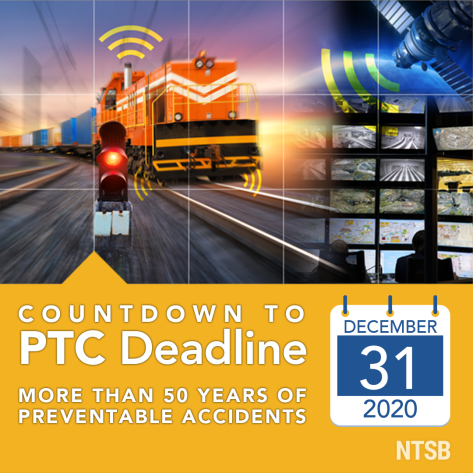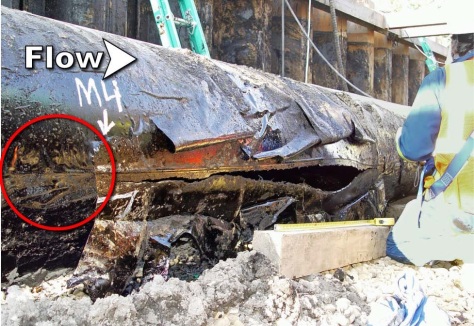December 31, 2020—not only will it be the last day of an incredibly challenging year that I think we’ll all be happy to put behind us, it’s also a significant day for railroad safety. It’s the final deadline for all 41 railroads to fully implement Positive Train Control (PTC). It’s been a long journey to get to this point and I’m thrilled to see the great progress that’s been made over the years. There were times no one believed we’d get to where we are today, so how did we get here?
PTC is a communications-based system designed to automatically stop a train before certain accidents occur. It won’t prevent all train accidents, like vehicle-train accidents at grade crossings or those caused by track and equipment failures, but it is designed to prevent train-to-train collisions, overspeed derailments, incursions into established work zones, and train movement through switches left in the wrong position.
The concept of PTC isn’t new. In fact, the NTSB has been urging railroads to implement PTC in some form—and federal regulators to mandate it—for over 50 years. Our first recommendation related to PTC (Safety Recommendation R‑70‑20) was issued following a deadly train collision in Darien, Connecticut, in August 1969, when two Penn Central commuter trains collided head on, killing 3 crew members and 1 passenger, and injuring 43 others. Twenty years later, the NTSB included PTC on its first Most Wanted List of transportation safety improvements (MWL), and, with the exception of 4 years following enactment of the Rail Safety Improvement Act of 2008 (RSIA; Public Law 110-432, Division A), it’s remained on the list to this day.

Before the passage of the RSIA, we had been recommending this lifesaving technology for decades, yet little action had been taken to implement its use. Even the Federal Railroad Administration (FRA), which is the federal agency charged by Congress with ensuring “the assignment and maintenance of safety as the highest priority,” had rebuffed repeated NTSB calls for implementing PTC, asserting that the technology was too expensive and that it would provide little safety benefit—a claim that was seemingly inconsistent with the August 1999 Railroad Safety Advisory Committee report, Implementation of Positive Train Control Systems, which found that, out of a select group of 6,400 rail accidents that occurred from 1988 to 1997, 2,659 could have been prevented if some form of PTC had been implemented.
Most people who follow the history of PTC will say it was the 2008 Metrolink crash in Chatsworth, California, that really brought PTC to the attention of Congress, but that’s not entirely true. In fact, it was a string of PTC‑preventable accidents that occurred in the early to mid-2000s that finally caused the issue to make headway. Six of these accidents were accidents that we investigated in 2004 and 2005. They occurred in Macdona, Texas; Graniteville, South Carolina; Anding, Mississippi; Shepherd, Texas; Chicago, Illinois; and Texarkana, Arkansas.
The ones I remember most were Macdona and Graniteville; they were, in part, the reason the PTC mandate applies, not just to main lines over which passengers are transported, but also to main lines over which poisonous or toxic-by-inhalation hazardous materials are transported.
On June 28, 2004, a Union Pacific (UP) freight train struck the midpoint of a BNSF freight train traveling on the same main line track as the BNSF train was entering a siding. Chlorine escaping from a punctured tank car immediately vaporized into a cloud of chlorine gas that engulfed the area. The conductor of the UP train and two Macdona residents died as a result of chlorine gas inhalation. About 30 others were treated for respiratory distress or other injuries related to the collision and derailment.
Just 6 months later, on January 6, 2005, a Norfolk Southern train transporting chlorine encountered a misaligned switch that diverted the train from the main line onto an industry track, where it struck an unoccupied, parked Norfolk Southern train, killing the 28-year-old train engineer, Chris Seeling, and eight others as a result of chlorine gas inhalation. About 554 people suffering from respiratory difficulties were taken to local hospitals; 5,400 others within a 1-mile radius of the derailment site were evacuated for several days.
Both accidents were preventable with PTC.
I wasn’t at the NTSB at the time. I was serving as staff director of the US House of Representatives Subcommittee on Railroads, Pipelines, and Hazardous Materials. Congressman James Oberstar (D-MN) had just been named chairman of the committee, and one of his first acts as chair was to launch a series of hearings focused on rail safety. (Coincidentally, the subcommittee’s first hearing on the topic was the first time Chairman Sumwalt, then an NTSB board member, testified before Congress.)
One of those was a field hearing held in March 2007 in San Antonio, Texas, where Ralph Velasquez, a resident of Macdona, described his family’s escape from “the cloud of chlorine” and the tremendous physical, mental, and emotional toll the accident had taken on his family and the entire community. Mr. Velasquez’s words were similar to those of Chris Seeling’s parents, who had visited me and Chairman Oberstar months earlier. Both families wanted action, including implementation of NTSB recommendations.
Two months later, Chairman Oberstar delivered on his promises. The House approved legislation that mandated longstanding NTSB recommendations and established a deadline for PTC implementation. The Senate passed its bill in 2008, and we were in the process of finalizing a bipartisan, bicameral bill to include PTC when a Metrolink commuter train collided head-on with a Union Pacific freight train, killing 25 people in Chatsworth, California.
The tragedy in Chatsworth—which the NTSB later determined was preventable with PTC—gave the legislation its final push, and in October, the RSIA was signed into law, mandating PTC implementation by December 31, 2015. This deadline was later extended by Congress to 2018, and then again by the FRA on a case-by-case basis to 2020.
Since the RSIA was signed into law in 2008, the NTSB has investigated 25 accidents that would’ve been prevented had PTC been implemented, including the overspeed derailments of Amtrak passenger train 188 in Philadelphia, Pennsylvania, which killed eight people onboard, and Amtrak passenger train 501 near DuPont, Washington, which took three lives and injured more than 50 others. In all, since that first accident investigation in 1969, over 300 people have been killed and almost 7,000 others have been injured in 154 accidents that the NTSB determined could have been prevented if PTC had been operational. When people think about the 2008 mandate and how long it’s taken the railroads to implement that mandate, they get frustrated with Congress for extending the deadline, but what they fail to remember is, if it weren’t for congressional action, we wouldn’t be where we are today. The railroads wouldn’t have implemented PTC voluntarily.
Today, PTC data submitted to the FRA is looking far more positive than in the past. Since I joined the Board in 2018, I’ve visited or spoken to a majority of the 41 railroads regarding their PTC status, and they’re mostly reporting good progress. Most railroads are expected to meet the end-of-year deadline, and I’m cautiously optimistic that all 41 will succeed.
Because of the NTSB’s tireless advocacy, beginning long before I joined the Board, and the hard work of our investigators, the finish line is at last in sight. Our investigators work diligently to prevent tragedies like Macdona and Graniteville from recurring. If Chairman Oberstar was alive today, he would call them heroes for their dedication and for all they’ve done to save lives.
Today marks 154 days until the latest deadline for PTC implementation. That’s also the number of PTC-related accidents we’ve investigated over the years. For the rest of this year, stay tuned to our social media channels, where we’ll share information daily about each of the accidents (look for #PTCdeadline). These accidents are a reminder of how much we’ve lost while waiting for the implementation of PTC.




 One speaker slated to join us in a panel discussion was Mike Patey, the pilot of the famous “Draco,” a Pzl Okecie PZL104, that experienced a
One speaker slated to join us in a panel discussion was Mike Patey, the pilot of the famous “Draco,” a Pzl Okecie PZL104, that experienced a 





